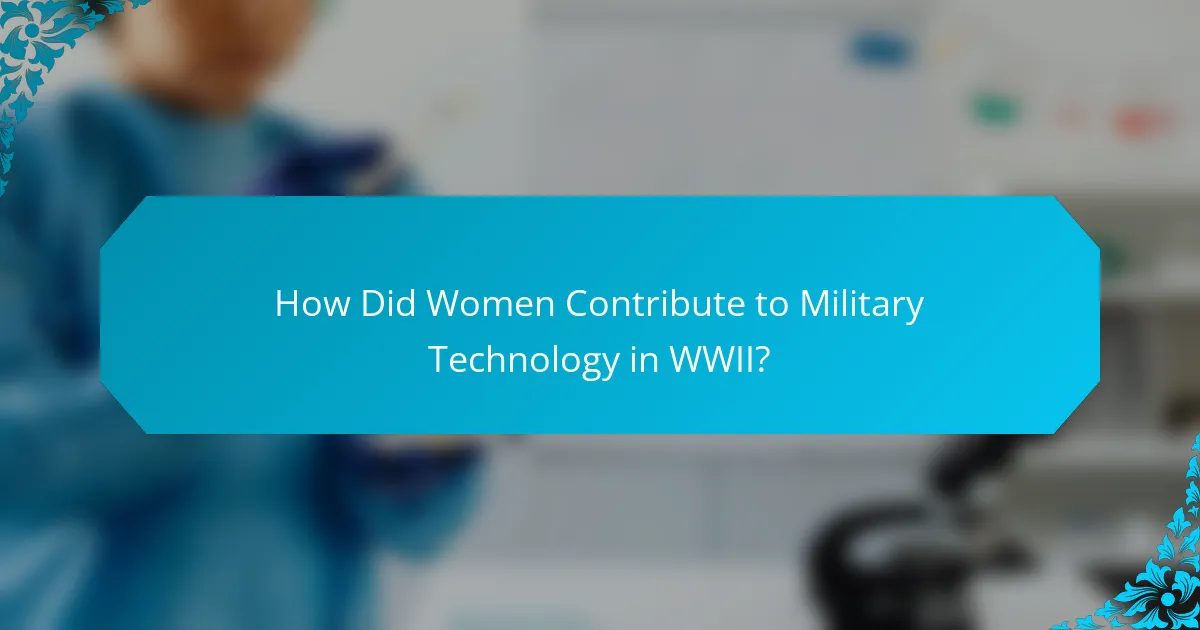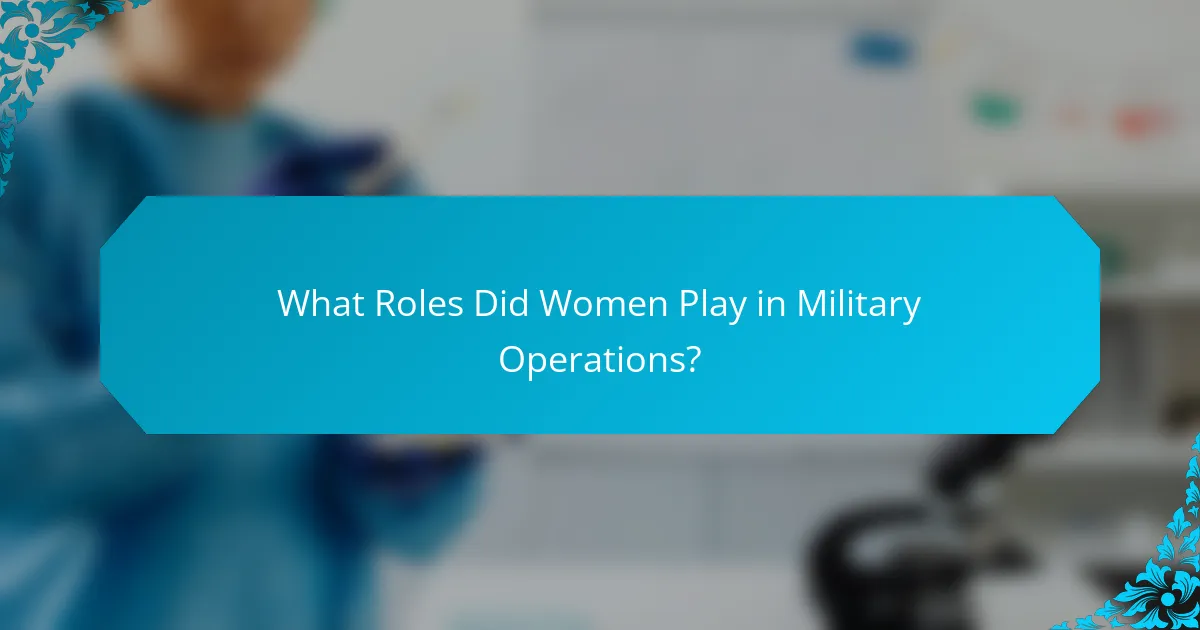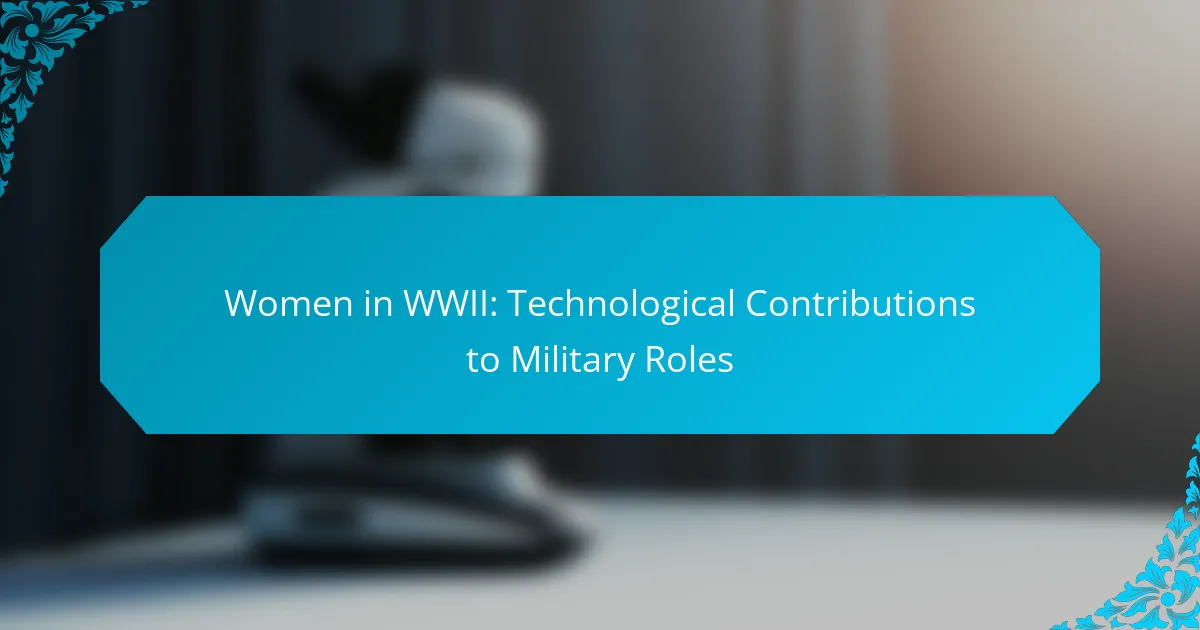During World War II, women made significant technological contributions that transformed military operations and production capabilities. Their involvement in fields such as radar, cryptography, and aircraft manufacturing not only enhanced the effectiveness of the armed forces but also set the stage for future advancements in gender roles within the workforce.

How Did Women Contribute to Military Technology in WWII?
Women played a crucial role in advancing military technology during World War II, significantly impacting various fields such as radar, cryptography, and aircraft manufacturing. Their contributions not only enhanced military efficiency but also paved the way for future technological developments.
Development of radar technology
Women contributed to the development of radar technology by taking on roles as technicians and engineers. They operated radar equipment, conducted maintenance, and participated in research and development efforts, helping to improve detection systems that were vital for air defense.
One notable group was the Women’s Army Corps, which trained women to operate radar systems. Their involvement was essential in increasing the accuracy and reliability of radar, which played a key role in military strategy during the war.
Advancements in cryptography
Women made significant strides in cryptography, particularly in codebreaking efforts. Many worked at the National Security Agency and other intelligence agencies, where they deciphered enemy communications and contributed to the development of secure communication methods.
The work of women like Joan Clarke and others at Bletchley Park in the UK was instrumental in breaking the Enigma code, which had a profound impact on the Allied war effort. Their analytical skills and attention to detail were critical in this high-stakes environment.
Innovations in aircraft manufacturing
In aircraft manufacturing, women filled roles on assembly lines and in engineering, contributing to the production of military aircraft. They were involved in building planes such as the B-17 and B-29 bombers, which were crucial for air operations.
Women often worked in challenging conditions, demonstrating remarkable skill and efficiency. Their contributions helped meet the urgent demand for aircraft, significantly boosting the military’s operational capabilities.
Medical advancements and nursing technologies
Women advanced medical technologies and nursing practices during WWII, often serving in military hospitals and as battlefield nurses. They were responsible for implementing new medical techniques and technologies that improved patient care and recovery rates.
Innovations included the use of blood plasma and advancements in surgical procedures. Women’s contributions in this field not only saved lives during the war but also laid the groundwork for modern military medicine.
Contributions to weaponry design
Women contributed to weaponry design by participating in research and development teams that created new weapons and improved existing ones. Their work included everything from small arms to artillery systems, ensuring that the military had effective tools for combat.
Examples include women working on the design of ammunition and explosives, where their insights helped enhance performance and safety. Their involvement in weapon design was critical in maintaining the technological edge of the military during the war.

What Roles Did Women Play in Military Operations?
Women played crucial roles in military operations during World War II, taking on various responsibilities that were essential to the war effort. They served in capacities ranging from pilots to support staff, significantly contributing to the effectiveness of the armed forces.
Women Airforce Service Pilots (WASP)
The Women Airforce Service Pilots (WASP) were among the first female pilots to fly military aircraft in the United States. Established in 1943, WASP pilots flew non-combat missions, including ferrying planes, training pilots, and conducting target towing for gunnery practice.
WASP pilots logged over 60 million miles of flight time, demonstrating their capabilities and proving that women could handle the demands of military aviation. Their contributions helped free male pilots for combat roles, highlighting the importance of women in military operations.
Women’s Army Corps (WAC) roles
The Women’s Army Corps (WAC) was established in 1942, allowing women to serve in various non-combat roles within the Army. WAC members took on responsibilities such as clerical work, medical support, and logistical planning, which were vital for maintaining military efficiency.
By the end of the war, hundreds of thousands of women had served in the WAC, showcasing their ability to perform essential tasks that supported frontline troops. Their involvement not only helped streamline operations but also paved the way for future generations of women in the military.
Navy WAVES contributions
The Navy WAVES (Women Accepted for Volunteer Emergency Service) was created in 1942 to allow women to serve in the Navy during World War II. WAVES members filled critical positions in administrative, medical, and technical fields, enabling the Navy to operate more effectively while men were deployed in combat.
WAVES served in various capacities, including radio operators, cryptographers, and intelligence analysts. Their contributions were instrumental in maintaining communication and operational readiness, demonstrating that women could excel in roles traditionally held by men.

What Impact Did Women’s Technological Contributions Have?
Women’s technological contributions during World War II significantly enhanced military operations and production capabilities, leading to lasting changes in gender roles. Their involvement not only improved efficiency but also paved the way for future advancements in women’s participation in the workforce.
Enhanced military efficiency
Women played a crucial role in enhancing military efficiency by taking on various technical and operational roles. They served as mechanics, engineers, and operators of advanced equipment, which allowed for smoother logistics and faster deployment of resources.
For example, women working in aircraft factories were instrumental in assembling planes and maintaining equipment, which directly contributed to the war effort. Their ability to adapt to new technologies quickly helped streamline operations and reduce downtime.
Increased production capabilities
The entry of women into the workforce during WWII led to a dramatic increase in production capabilities across various sectors. With men deployed overseas, women filled essential roles in factories, producing munitions, vehicles, and other military supplies.
By the end of the war, women comprised a significant portion of the workforce, with estimates suggesting they produced over half of the military equipment needed. This shift not only met wartime demands but also demonstrated women’s ability to perform in traditionally male-dominated industries.
Shifts in gender roles post-war
The technological contributions of women during WWII initiated significant shifts in gender roles that persisted long after the conflict ended. As women proved their capabilities in various technical fields, societal perceptions began to change, leading to increased acceptance of women in the workforce.
Post-war, many women sought to retain their jobs or pursue careers in technology and engineering, challenging traditional gender norms. This shift laid the groundwork for future movements advocating for gender equality in the workplace and contributed to the ongoing conversation about women’s rights and opportunities in various industries.

What Are the Criteria for Recognizing Women’s Contributions?
Recognizing women’s contributions during WWII involves evaluating their roles based on historical documentation, inclusion in military history curricula, and acknowledgment in public memorials. These criteria help ensure that their significant technological advancements and military service are properly credited and remembered.
Historical documentation standards
Historical documentation standards require that contributions by women in WWII be recorded in official military archives, personal accounts, and scholarly research. This includes maintaining accurate records of their roles in various capacities, such as engineers, pilots, and support personnel. Documentation should be comprehensive, reflecting the diverse experiences and contributions of women across different branches of the military.
Efforts to standardize documentation can include the establishment of guidelines for historians and researchers to follow, ensuring consistency and accuracy in how women’s contributions are portrayed. This can also involve the digitization of records to make them more accessible for future generations.
Inclusion in military history curricula
Inclusion in military history curricula is crucial for educating future generations about the vital roles women played during WWII. Educational institutions should integrate these contributions into their programs, highlighting specific examples of women’s technological advancements and military service. This can help combat the historical narrative that often overlooks or minimizes their impact.
Curricula can include case studies, primary source materials, and discussions that focus on women’s achievements, such as the contributions of the Women Airforce Service Pilots (WASP) or the work of female cryptographers. Engaging students with these stories fosters a more comprehensive understanding of military history.
Recognition in public memorials
Recognition in public memorials serves as a powerful way to honor women’s contributions during WWII. Memorials should not only commemorate male soldiers but also include tributes to women who served in various capacities. This can involve the creation of dedicated monuments or plaques that specifically acknowledge their roles and sacrifices.
Communities can advocate for the inclusion of women’s stories in existing memorials, ensuring that their contributions are visible and respected. Public ceremonies and educational programs can further enhance awareness and appreciation of women’s roles in military history, fostering a more inclusive narrative.

How Can We Learn More About Women in WWII?
To learn more about the contributions of women in WWII, explore various resources such as books, documentaries, and museum exhibitions. These materials provide in-depth insights into their roles and technological advancements during the war.
Books and documentaries
Numerous books and documentaries focus on the significant roles women played during WWII, particularly in technology and military operations. Titles like “Women in War: The Story of Women in the Second World War” and documentaries such as “The Women Who Dared” offer compelling narratives and factual accounts.
When selecting resources, consider those that include personal stories and firsthand accounts, as they often provide a more vivid understanding of the experiences women faced. Look for works that highlight lesser-known figures and their contributions to military technology.
Museum exhibitions
Visiting museums that feature exhibitions on WWII can provide valuable insights into women’s contributions. Institutions like the Imperial War Museum in London and the National WWII Museum in New Orleans often showcase artifacts, photographs, and interactive displays that highlight women’s roles in the military.
Check for traveling exhibitions or local museums that may host temporary displays focused on women’s contributions during the war. Engaging with these exhibits can enhance your understanding and appreciation of the technological advancements driven by women during this pivotal time.



